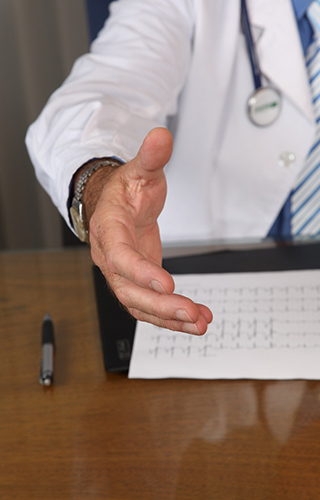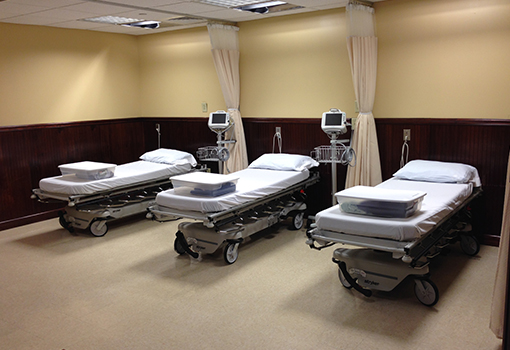Diverticulosis
What is it?
Diverticulosis, coming from the Latin word diverticulum, means a small pouch or weak spot in the colon or large intestine which yields to pressure from food or gas within the colon. Tiny pockets of the membrane lining of the colon are pushed out from the inside of the intestinal wall to form small sacs or pouches (pockets) about the size of the rubber tip of a lead pencil. These pouches are called diverticula.
Diverticula can develop anywhere in the digestive tract but they usually occur in the colon, predominantly in the left portion, called the sigmoid colon.
How serious a disorder is it?
While it can be uncomfortable and burdensome, diverticulosis, in itself, is not a serious condition. However, it can lead to diverticulitis, in which the pouches become inflamed or infected and can perforate or rupture. Occasionally, the pouches may erode into blood vessels and cause bleeding. Generally, perforation and bleeding of diverticula can be controlled medically. Sometimes, hospitalization and surgical treatment are required to control these complications.
Fortunately, these complications of diverticulosis can be avoided. The condition has no direct relation to cancer.
What causes it?
The precise cause of diverticulosis is unknown. The process of aging and muscle shrinkage may weaken the wall of the colon, allowing the pouches to develop. In most case studies, an abnormal thickening of the muscle wall of the colon producing very high pressures inside the colon have been found and it is thought that this might predispose to the development of the pouches (diverticula).
Fiber deficiency, a leading cause of constipation, results in small hard stools that do not fill out the colon. The colon then develops areas of spasm which force the pouches through the muscle wall.
While constipation, in itself, has not been shown to be a causative factor, the regular use and abuse by millions of Americans of potent laxatives, cathartics, and purgatives to cleanse their bowels may well be a contributing factor. Repeated use of these agents, instead of correcting the constipation, only makes it worse.
Probably, the principle factor in the high incidence of diverticulosis among Americans is the low residue, low fiber diet consumed in Western countries. Africans and Orientals living in rural areas who eat plenty of natural fiber or roughage rarely get diverticulosis.
Fiber is a non-nutrient but it is essential for normal bowel function.


Can a diet high in fiber prevent this?
yes. A high roughage diet will not only prevent the development of diverticulosis but will help treat it once it is established. It will also help correct constipation due to improper diet.
How does one know if he has diverticulosis?
Often, the patient doesn’t know. Most people, even with widespread diverticulosis, have no symptoms. When there are symptoms, they usually include “gas”, stomach cramps, pain and diarrhea alternating with constipation, especially in older people.
Aren’t these symptoms common in other disorders?
Yes, including some serious diseases; that is why you went through all those tests. Before making a diagnosis of diverticulosis, we must first exclude all other possible causes of the symptoms. X-ray and instrument examination of the colon will confirm the diagnosis distinguishing diverticulosis from other diseases of the colon with similar symptoms. Such as irritable bowel syndrome.
How is it treated?
Treatment of diverticulosis is mainly dietary. The condition can usually be cleared up simply by the maintenance of a high fiber diet. the easiest way to do this is to eat bran cereal every day. Bran, the outer coating of the whole wheat whcih is removed in the processing of grain, has a higher percentage of non-nutritive or dietary fiber. Pure bran, which has even a higher percentage of fiber than bran cereals, can be purchased in health food stores. Twenty-five or more grams of fiber is recommended daily.
While pure bran is very dry, it has almost no taste of its own and can be mixed into cottage cheese, yogurt, spaghetti, hamburger, and many other foods. It is not only high in fiber, but it is also an excellent “stretcher.”
Psyllium seed commercial preparations (Metamucil or Citrucil), may be prescribed in your case to supplement the fiber in your diet. Medications to reduce the muscular spasm in your colon may also be prescribed for a limited time.
Fresh fruits and vegetables are also high in roughage, and you can have all you want. In fact, there are no dietary restrictions whatsoever: just make sure you get enough fiber. And be equally sure that you drink enough fluids every day.

Should I feed bran to my children in this manner?
Yes. The bran will not even be noticed. Ad you should also see that your children eat raw fruits and vegetables and other high roughage foods. The best way to prevent intestinal abnormalities in later life is to introduce proper dietary habits at an early age.
How long should I remain on a high fiber diet?
Permanently – for as long as you feel well. The fiber you put back into your normal diet will help to regular your bowel movement and spasm. Gradually, the program will become a way of life for you. Most people who go on a high fiber diet experience such a dramatic improvement that they never revert to their old eating habits.
The only time to change this diet is in the event of the development of diverticulitis, with perforation of one of the pouches. Then, treatment with antibiotics and low residue is necessary. In some cases when patients do not respond to these simple measures and complications develop, hospitalization and surgery may also be required.
What are my chances of developing diverticulitis?
About 15% of patients with diverticulosis develop diverticulitis – and the percentage is even smaller for those on a high fiber diet. Only about 10% of patients with diverticulitis require surgery. With prompt treatment, the complications of diverticulosis can usually be controlled. So it is important to see your doctor at the first appearance of symptoms – severe abdominal pain and fever.
When the illness is controlled and the patient is able to leave the hospital, he should return to a high residue diet. One thing he should definitely not do, if constipation occurs, is to return to the futile and harmful practice of subjecting his colon to cathartics. There are safer and more effective methods of overcoming this problem.

